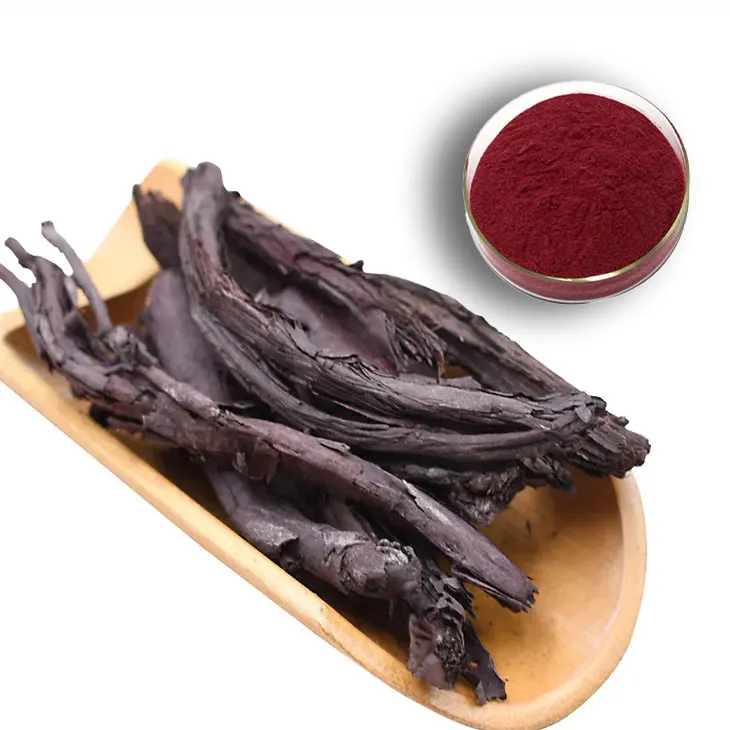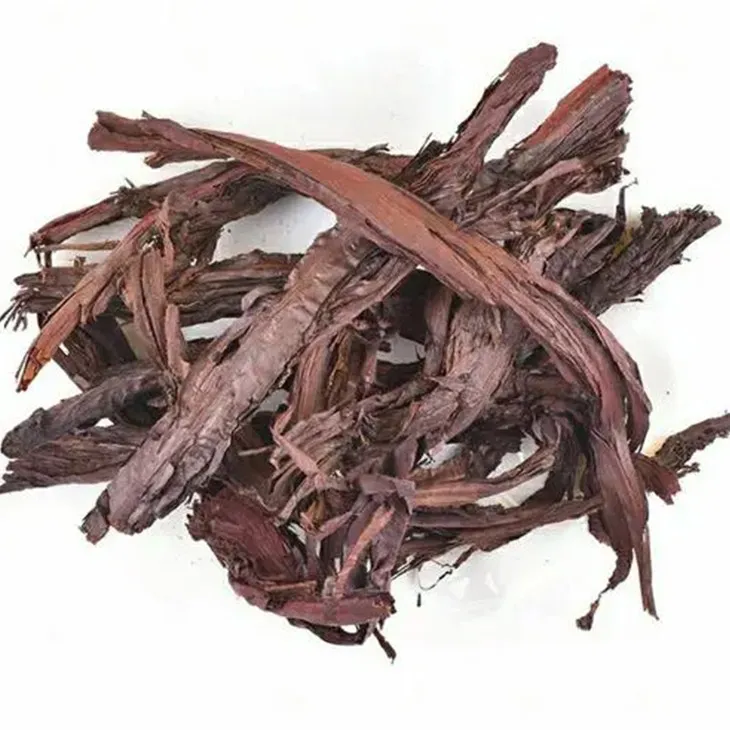- 0086-571-85302990
- sales@greenskybio.com
Shikonin: China vs. the United States.
2024-11-28

1. Introduction to Shikonin
Shikonin is a remarkable compound that has drawn significant attention in both China and the United States due to its diverse biological activities. It is a natural product with great potential in the fields of medicine, cosmetics, and more. Shikonin has properties such as anti - inflammatory, anti - tumor, and antioxidant activities, which make it a valuable target for research and development.

2. Shikonin in China
2.1 Traditional Medicine Roots
In China, shikonin is deeply rooted in traditional medicine knowledge systems. For centuries, Chinese traditional medicine has recognized the value of plants containing shikonin. These plants have been used to treat various ailments, such as skin diseases, burns, and internal inflammations. The traditional knowledge has served as a foundation for modern research on shikonin in China.
2.2 Research on Extraction Techniques
Chinese researchers have been actively carrying out research on shikonin extraction techniques from natural sources. They are constantly striving to improve the yield and purity of shikonin extraction. Through various methods such as solvent extraction, supercritical fluid extraction, and microwave - assisted extraction, they aim to obtain high - quality shikonin in a more efficient and environmentally friendly way. For example, some studies have focused on optimizing the solvent composition and extraction conditions to increase the yield of shikonin from traditional Chinese medicinal plants.
2.3 Combination with Other TCM Ingredients
Another aspect of Chinese research on shikonin is the exploration of its combination with other traditional Chinese medicine ingredients. Chinese medicine often emphasizes the synergy between different herbs and compounds. Researchers are investigating how shikonin can interact with other components to enhance its efficacy. For instance, in the treatment of skin diseases, shikonin may be combined with other herbs known for their anti - inflammatory and wound - healing properties in traditional Chinese medicine. This approach not only takes advantage of shikonin's individual properties but also harnesses the holistic benefits of traditional Chinese medicine formulations.

3. Shikonin in the United States
3.1 Integration into Western Medicine Research
In the United States, shikonin research is often part of the broader search for novel therapeutics in Western medicine. American researchers view shikonin as a potential source of new drugs. They are interested in exploring its mechanisms of action at the molecular level and how it can be used to treat various diseases, especially those with unmet medical needs. For example, in the field of oncology, shikonin is being studied for its potential to target cancer cells while sparing normal cells.
3.2 Pre - clinical and Clinical Trials
American researchers are more likely to conduct pre - clinical and clinical trials in line with international standards. These trials are crucial for evaluating the safety and efficacy of shikonin - based therapies. In pre - clinical trials, researchers use in vitro and in vivo models to study the pharmacokinetics and pharmacodynamics of shikonin. In clinical trials, they enroll patients to test the effectiveness of shikonin - containing drugs in a real - world setting. The strict regulatory environment in the United States ensures that these trials are carried out with high quality and transparency.

4. Patent Protection and Intellectual Property Management
4.1 The Situation in China
In China, patent protection for shikonin - related research has been evolving. China has made significant progress in recent years in strengthening its intellectual property protection system. However, compared to the United States, there are still some differences. Chinese researchers may face challenges in protecting their inventions related to shikonin, especially in the international market. For example, in some cases, Chinese traditional medicine knowledge, which forms the basis for shikonin research, may not be fully recognized in international patent systems.
4.2 The Situation in the United States
The United States has a well - established and highly sophisticated patent protection and intellectual property management system. American companies and researchers are often more experienced in obtaining patents for their shikonin - related research. This gives them an advantage in terms of commercialization and international cooperation. For instance, they can more easily attract investment and form partnerships based on the strength of their intellectual property rights.
5. Impact on the Development and International Cooperation of Shikonin - Related Industries
5.1 Development in China
The differences in patent protection and intellectual property management in China have both positive and negative impacts on the development of shikonin - related industries. On the positive side, the rich traditional medicine knowledge provides a solid foundation for innovation. Chinese companies can develop shikonin - based products with unique features by leveraging traditional medicine concepts. However, on the negative side, the challenges in international patent protection may limit the global market access of Chinese shikonin - related products. To overcome these challenges, Chinese companies and researchers need to enhance their understanding of international patent rules and strengthen international cooperation.
5.2 Development in the United States
In the United States, the strong patent protection and advanced research infrastructure contribute to the rapid development of shikonin - related industries. American companies can invest more confidently in research and development, knowing that their intellectual property rights are well protected. Moreover, they can easily collaborate with international partners based on their strong intellectual property position. However, the high cost of conducting clinical trials and the strict regulatory requirements also pose challenges to the development of shikonin - related industries in the United States.
5.3 International Cooperation
The differences in patent protection and research approaches between China and the United States also affect international cooperation in the field of shikonin. On one hand, there is great potential for cooperation as both countries have their own strengths. China can contribute its traditional medicine knowledge and extraction techniques, while the United States can offer its experience in pre - clinical and clinical trials and international patent protection. On the other hand, the differences in intellectual property management may lead to some frictions in cooperation. For example, issues such as ownership of intellectual property rights and sharing of benefits need to be carefully negotiated in cross - border collaborations.
6. Conclusion
In conclusion, shikonin is an important compound that is being actively studied in both China and the United States. While China focuses on traditional medicine - based research and extraction techniques, the United States emphasizes Western - style pre - clinical and clinical trials. The differences in patent protection and intellectual property management between the two countries have a significant impact on the development and international cooperation of shikonin - related industries. To fully realize the potential of shikonin, it is crucial for both countries to enhance communication and cooperation, learn from each other's strengths, and address the challenges together.
FAQ:
What are the main differences in shikonin research between China and the United States?
In China, shikonin research is deeply influenced by traditional medicine knowledge systems. China focuses on extraction techniques from natural sources to improve yield and purity, and also studies its combination with other traditional Chinese medicine ingredients. In the United States, shikonin research is part of the search for novel therapeutics in Western medicine, and American researchers are more likely to conduct pre - clinical and clinical trials according to international standards.
How does the research on shikonin extraction techniques differ between China and the United States?
In China, research on shikonin extraction techniques mainly aims at improving the yield and purity from natural sources. In the United States, there may be more emphasis on extraction techniques that are suitable for Western medicine research paradigms, such as those related to pre - clinical and clinical trial requirements, but specific information on extraction techniques may vary depending on different research projects.
What role does traditional medicine play in China's shikonin research?
Traditional medicine in China plays a fundamental role in shikonin research. It provides a knowledge base for understanding shikonin's properties. Chinese researchers often explore the combination of shikonin with other traditional Chinese medicine ingredients based on traditional medicine knowledge, aiming to enhance its efficacy.
How do patent protection and intellectual property management of shikonin - related research differ between the two countries?
The patent protection and intellectual property management of shikonin - related research in China and the United States vary greatly. In the United States, the intellectual property system is more in line with Western - style commercial and research models, with strict regulations and a well - established framework for protecting research findings. In China, the intellectual property system has been continuously developing and improving, and it also takes into account the characteristics of traditional medicine research. However, the specific differences are complex and are related to legal regulations, research cultures, and commercial environments in both countries.
What are the potential impacts of the differences in shikonin research between China and the United States on international cooperation?
The differences in shikonin research between China and the United States can have both positive and negative impacts on international cooperation. On the positive side, the different research focuses can lead to complementary knowledge and technology sharing. For example, China's experience in traditional medicine - related research can provide new ideas for American research, and American pre - clinical and clinical trial standards can be a reference for Chinese research. However, differences in patent protection and intellectual property management may cause some obstacles in cooperation, such as disputes over intellectual property rights and difficulties in aligning research interests.
Related literature
- Shikonin: Traditional and Modern Perspectives"
- "Shikonin Research in the Context of Global Medicine: A Comparison between East and West"
- "The Role of Shikonin in Chinese and American Pharmaceutical Research"
- ▶ Hesperidin
- ▶ Citrus Bioflavonoids
- ▶ Plant Extract
- ▶ lycopene
- ▶ Diosmin
- ▶ Grape seed extract
- ▶ Sea buckthorn Juice Powder
- ▶ Fruit Juice Powder
- ▶ Hops Extract
- ▶ Artichoke Extract
- ▶ Mushroom extract
- ▶ Astaxanthin
- ▶ Green Tea Extract
- ▶ Curcumin
- ▶ Horse Chestnut Extract
- ▶ Other Product
- ▶ Boswellia Serrata Extract
- ▶ Resveratrol
- ▶ Marigold Extract
- ▶ Grape Leaf Extract
- ▶ New Product
- ▶ Aminolevulinic acid
- ▶ Cranberry Extract
- ▶ Red Yeast Rice
- ▶ Red Wine Extract
-
Curcuma Longa Extract
2024-11-28
-
Andrographis Paniculata Extract Powder
2024-11-28
-
Eucommia Ulmoides Extract
2024-11-28
-
Sugarcane Extract
2024-11-28
-
Ginseng Root Extract
2024-11-28
-
Berberis aristata Extract
2024-11-28
-
Beta Carotene
2024-11-28
-
Polygonum multiflorum extract
2024-11-28
-
Mulberry Extract
2024-11-28
-
Bitter Melon Extract
2024-11-28





















